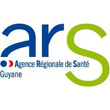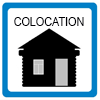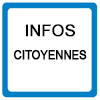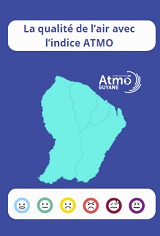Blada.com
mercredi 24 décembre
Boîtes aux lettres
Courrier des lecteurs
Petites annonces
Emploi / Formation
Covoiturage
Infos citoyennes
Infos citoyennes
17/12/21
Une marche en avant de la Guyane vers son CHU
 La pose de la première pierre du bâtiment enseignement et recherche, mardi matin au centre hospitalier de Cayenne, représente bien plus que le lancement symbolique du chantier, d’ici à quelques semaines. Ce premier parpaing, scellé par les chercheurs guyanais, les autorités sanitaires, éducatives et politiques regroupées, préfigure et matérialise la mise en place du futur CHRU de Guyane. Une étape majeure depuis l’annonce en mars 2021, par le gouvernement, du lancement d’un plan pour sa mise en place en 2025.
La pose de la première pierre du bâtiment enseignement et recherche, mardi matin au centre hospitalier de Cayenne, représente bien plus que le lancement symbolique du chantier, d’ici à quelques semaines. Ce premier parpaing, scellé par les chercheurs guyanais, les autorités sanitaires, éducatives et politiques regroupées, préfigure et matérialise la mise en place du futur CHRU de Guyane. Une étape majeure depuis l’annonce en mars 2021, par le gouvernement, du lancement d’un plan pour sa mise en place en 2025.
« C’est un instant, il faut le savourer », insiste le Pr Mathieu Nacher, médecin épidémiologiste à l’hôpital de Cayenne. Mardi matin, lors de la pose de la première pierre du bâtiment enseignement et recherche, dans l’enceinte du centre hospitalier de Cayenne. Le directeur du centre d’investigations cliniques (CIC) n’a pas été le seul à mettre en relief cette activité au sein de la communauté médicale, en particulier, et à la définir, d’un point de vue général, comme l’un des éléments nécessaires à la mise en place d’un CHRU en Guyane d’ici à 2025, validée ces derniers mois par le gouvernement.
 « Il y a vingt ans, quand on parlait de recherche à la CME (commission médicale d’établissement), tout le monde s’en moquait, ce n’était pas un hôpital de recherche. Vingt ans plus tard, les choses ont énormément bougé », ajoute-t-il, en ne mâchant pas ses mots. Une importance que rappelle aussi le Pr Félix Djossou, chef de l’unité des maladies infectieuses et tropicales : « Cela fait partie des missions qui nous sont prescrites, quand nous prenons nos fonctions. Tous les praticiens hospitaliers, même non universitaires, ont un devoir de recherche. Dans la perspective du CHRU qui est imminente, cette nécessité prend tout son sens. On va avoir un outil qui va nous permettre d’assurer cette mission dans notre environnement guyanais mais davantage au niveau amazonien et plus encore. »
« Il y a vingt ans, quand on parlait de recherche à la CME (commission médicale d’établissement), tout le monde s’en moquait, ce n’était pas un hôpital de recherche. Vingt ans plus tard, les choses ont énormément bougé », ajoute-t-il, en ne mâchant pas ses mots. Une importance que rappelle aussi le Pr Félix Djossou, chef de l’unité des maladies infectieuses et tropicales : « Cela fait partie des missions qui nous sont prescrites, quand nous prenons nos fonctions. Tous les praticiens hospitaliers, même non universitaires, ont un devoir de recherche. Dans la perspective du CHRU qui est imminente, cette nécessité prend tout son sens. On va avoir un outil qui va nous permettre d’assurer cette mission dans notre environnement guyanais mais davantage au niveau amazonien et plus encore. »
Ce moment, le président de l’Université le juge important : « Cela va transformer la Guyane, en matière d’offre de soins et de formation des professionnels de santé, au sens large, dans le domaine de la médecine mais aussi des métiers du paramédical », souligne Antoine Primerose.
« Ce sera un bâtiment surprenant »
Pierre angulaire du futur CHRU, le bâtiment, d’un coût estimé à 7,2 millions d’euros HT, couvrira une surface de 2 650 m2. « La construction doit démarrer en janvier et s’étaler sur un an, comme l’a indiqué l’architecte et maître d’œuvre Jérémy Tourret (, son agence, est spécialisée depuis quarante ans dans la construction de bâtiments hospitaliers et de recherche) associé localement au cabinet Gaïa architecture représenté par Paul Tritsch qui « va assurer le relais de la réalisation du projet ».
Le projet est formé de deux entités, l’une fermée, en forme de L et l’autre ouverte. Il se répartira sur trois niveaux : au rez-de-chaussée les espaces d’enseignement et la zone de recherche de l’autre ; au premier étage les espaces partagés du personnel ; au second étage, les espaces tertiaires. « Ce projet est très attendu par les équipes locales, poursuit Jérémy Tourret. Il va permettre de regrouper les utilisateurs dont le but est de créer un véritable département de santé amazonienne. Notre travail d’architecte a été d’imaginer un bâtiment fédérateur, qui soit une vraie vitrine pour le CH de Cayenne. » L’architecte précise aussi qu’il y aura « deux grandes façades en résille bois qui sont habillées par des limbes en bois verticales, qui en créant un jeu assez dynamique, viennent fermer le cube. Ce sera assez surprenant avec une vraie vie à l’intérieur. »
« Une feuille de route ambitieuse nous attend »

« Ça y est ! On entre aujourd’hui dans une phase d’action avec la pose de la première pierre. C’est un beau pari architectural », lâchait, avec soulagement, quelques minutes auparavant en ouverture de la cérémonie Christophe Robert, directeur du CHC. « Ce bâtiment, il participe de l’ensemble de ces décisions qui visent à redresser et à modifier l’image de l’établissement de Cayenne. Un certain nombre de personnes se complaisent dans une forme de misérabilisme à l’endroit de cet établissement. Ils ont tort et la suite des événements pourra leur donner franchement tort. »
La réalisation de ce nouveau bâtiment est donc un élément clé dans la création du futur CHU. « Derrière les activités qu’il va porter, poursuit le directeur, nommé à la tête de l’établissement en 2019, il y a la création d’une DRCI (délégation à la recherche clinique et à l’innovation). Il y a tout ce volet université, recherche, enseignement qui va être porté par cette très belle réalisation. » C’est un des éléments qui concourt à la création d’un CHU, comme le souligneront ensuite dans leurs allocutions d’autres participants à cette pose de première pierre, mais ce n’est pas le seul, prévient Christophe Robert. « Il y a un élément fort qui nous mobilise aujourd’hui : c’est bien sûr l’offre de soins. Avant de devenir CHU, il faut obtenir la labellisation CHR (centre hospitalier régional). C’est une feuille de route assez ambitieuse qui nous attend. L’ensemble des équipes se mobilisent et sont totalement immergées dans ce beau projet. »
Présidente du conseil de surveillance depuis septembre 2017, Mylène Mazia (qui va prochainement quitter ses fonctions) évoque à son tour « l’aboutissement d’un long processus et surtout le résultat de l’engagement d’une équipe ambitieuse des professeurs et des médecins du centre hospitalier de Cayenne regroupés au sein du centre d’investigation clinique labellisé Inserm et engagés dans la recherche en santé au niveau local, national et International. » La présidente confirme aussi que depuis quelques semaines, ce projet est devenu une réalité « grâce aux équipes… Ce nouvel outil permettra de propulser la recherche guyanaise plus loin et encore plus haut. »
La récompense d’un long et dur travail
Le soulagement est donc unanime. Mais cela n’a pas toujours été facile reprend le professeur Nacher. « On ne se rend pas forcément compte que cela a été difficile. Il y a une dizaine d’années, il y avait eu une tentative… Le projet avait été révoqué car non éligible car il fallait plus de 25 enseignants chercheurs statutaire en santé… Mais ce travail a été utile, ça mature les idées. »
« Ce rêve fou », dixit également Mathieu Nacher, repose aussi sur le travail des équipes médicales. « Depuis les vingt dernières années, il y eu 821 publications scientifiques par l’hôpital de Cayenne. Par comparaison, durant la même période, il y en a eu une centaine à Paramaribo (Suriname), 10 à Macapa (état brésilien voisin). L’institut de médecine tropicale du Portugal à Lisbonne en a cumulé 500, le Chog, une centaine… On fait des choses qui ne sont pas reconnues car pas visibles. Mais un beau bâtiment comme celui-là, ça va le permettre. On pourra aussi accueillir des personnes, accélérer la vie intellectuelle, par des séminaires d’écriture scientifique, lors de discussions, d’interactions entre les questionnements pour aller plus loin, plus haut (…) Ce bâtiment sera un outil formidable avec un amphithéâtre où la vie hospitalière, les chercheurs en santé avec les collègues de Pasteur pourront vraiment faire ce qu’ils n’ont jamais fait, car il y avait des problèmes de salles… J’imagine déjà ce que tout cela va représenter. Maintenant, il va falloir pédaler derrière vite pour continuer à tenir le rang, et la responsabilité que l’on a en Amérique du Sud. »
« 2025, c’est demain »
Avant d’arriver à la pose de cette première pierre, « il a fallu se battre pour sanctuariser les financements. L’établissement s’est totalement mobilisé, a insisté à plusieurs reprises Christophe Robert. L’ARS (Agence régionale de santé) a été à nos côtés pour convaincre nos bailleurs et nos tutelles de l’importance de ce projet qui est un élément essentiel de la feuille de route qui mène au CHU, validé par l’Igas dans son rapport. Elle a appuyé le financement de cette opération et a par ailleurs décidé d’une délégation d’avance sur cinq ans de financement de création d’une DRCI. C’est dire l’importance qu’elle attache à la recherche dans le cadre de la création d’un CHU. » Ce « bel outil, décrit par Thibault Lechat-Vega, 3e vice-président de la CTG, a été rendu possible par l’action territoriale via les fonds européens. Cela montre notre capacité à répondre aux besoins du territoire », précise l’élu.
Et le président de l’Université d’acquiescer : « On va réussir parce que nous avons de l’ambition. C’est un projet collectif qui fédère. On est sur la bonne marche. Il faut que tout le monde s’empare du sujet, qu’on s’en imprègne et que l’on continue à avancer en équipe. 2025, c’est demain, c’est très proche. Le GHT apporte un très bon signal à l’organisation du dispositif de santé. Il n’y aura pas de CHRU si l’université ne conventionne pas avec un établissement public de santé. Et la transformation du DFR santé en UFR médecine. L’université est mobilisée. »
« Une terre d’excellence »
Faisant écho aux diverses allocutions de la matinée, et en guise de résumé, la directrice générale de l’ARS, Clara de Bort souligne le côté « structurant de ce bâtiment de recherche. C’est devenu nécessaire pour l’attractivité de l’établissement et du territoire. Nous avons une responsabilité régionale, continentale voire mondiale sur la question de la santé tropicale. C’est ici plus qu’ailleurs que la santé tropicale amazonienne se crée, se comprend. C’est ici que l’on peut mieux comprendre l’environnement qui est si peu connu de nos voisins qui sont moins outillés que nous. Il faut assumer cette responsabilité. C’est vraiment grâce à des petites équipes que nous avançons. Notre devoir, c’est de les aider. C’est de leur permettre de se réunir car la recherche, ce n’est jamais une personne toute seule dans son bureau. Une recherche qui soit tout proche du lit du malade. C’est aussi auprès du malade que l’on apprend, comprend et enseigne des choses. C’est aussi un appui des cliniciens que d’avoir des chercheurs tout à côté. C’est vraiment l’amélioration de la qualité des soins que nous ambitionnons aussi avec ce type d’infrastructure. »
« Il nous faut une recherche de qualité et un rayonnement. La Guyane est une terre d’excellence, analyse le préfet, Thierry Quéffelec. C’est la porte d’entrée de la France en Amérique latine. Le petit poucet que nous sommes en Amérique latine a la qualité de ce que les valeurs françaises ont su mettre en place sur ce territoire : de la pertinence, de l’éducation, du recul et des savoir-faire. »
Cet article est issu de la Lettre pro de l’Agence régionale de santé. Vous pouvez vous y abonner en remplissant le formulaire suivant : https://forms.sbc28.com/5a8bed50b85b5350ef1cd117/t13M7zUZQi2XMq5E3DdnhQ/0WQoeDwjRXqJblCpKbLDzA/form.html
 The laying of the first stone of the teaching and research building on Tuesday morning at the Cayenne hospital center represents much more than the symbolic launch of the site, within a few weeks. This first concrete block, sealed by Guianese researchers, health, education and political authorities together, foreshadows and materializes the establishment of the future CHRU in French Guiana. A major step since the government announced in March 2021 of the launch of a plan for its implementation in 2025.
The laying of the first stone of the teaching and research building on Tuesday morning at the Cayenne hospital center represents much more than the symbolic launch of the site, within a few weeks. This first concrete block, sealed by Guianese researchers, health, education and political authorities together, foreshadows and materializes the establishment of the future CHRU in French Guiana. A major step since the government announced in March 2021 of the launch of a plan for its implementation in 2025.
"It's a moment, you have to savor it," insists Professor Mathieu Nacher, epidemiologist at Cayenne hospital. Tuesday morning, during the laying of the first stone of the teaching and research building, in the grounds of the Cayenne hospital center. The director of the clinical investigation center (CIC) was not the only one to highlight this activity within the medical community, in particular, and to define it, from a general point of view, as the one of the elements necessary for the establishment of a CHRU in French Guiana by 2025, validated in recent months by the government.
 “Twenty years ago, when we talked about research at the CME (Institutional Medical Board), nobody cared, it was not a research hospital. Twenty years later, things have changed enormously, ” he adds, not mince words. An importance that Professor Félix Djossou, head of the infectious and tropical diseases unit, also recalls: "This is one of the missions that are prescribed to us when we take office. All hospital practitioners, even non-university practitioners, have a research duty. From the perspective of the imminent CHRU, this necessity takes on its full meaning. We are going to have a tool that will allow us to carry out this mission in our Guianese environment, but more in the Amazon and more. "
“Twenty years ago, when we talked about research at the CME (Institutional Medical Board), nobody cared, it was not a research hospital. Twenty years later, things have changed enormously, ” he adds, not mince words. An importance that Professor Félix Djossou, head of the infectious and tropical diseases unit, also recalls: "This is one of the missions that are prescribed to us when we take office. All hospital practitioners, even non-university practitioners, have a research duty. From the perspective of the imminent CHRU, this necessity takes on its full meaning. We are going to have a tool that will allow us to carry out this mission in our Guianese environment, but more in the Amazon and more. "
This moment, the president of the University considers it important: "This will transform French Guiana, in terms of the offer of care and training of health professionals, in the broad sense, in the field of medicine but also of professions. paramedical,” emphasizes Antoine Primerose.
"It will be a surprising building"
Cornerstone of the future CHRU, the building, at an estimated cost of 7.2 million euros excluding tax, will cover an area of 2,650 m2. “Construction is due to start in January and take place over a year, as the architect and project manager Jérémy Tourret (his agency has specialized for forty years in the construction of hospital and research buildings) indicated. locally associated with the Gaïa architecture firm represented by Paul Tritsch who “will take over the implementation of the project”.
The project is made up of two entities, one closed, L-shaped and the other open. It will be spread over three levels: on the ground floor the teaching areas and the research area of the other; on the first floor the shared staff spaces; on the second floor, the tertiary spaces. "This project is eagerly awaited by the local teams," continues Jérémy Tourret. It will bring together users whose goal is to create a real Amazonian health department. Our architect's job was to imagine a unifying building, which would be a real showcase for the CH Cayenne." The architect also specifies that there will be "two large wooden mesh facades which are dressed in vertical wooden limbo, which by creating a fairly dynamic game, close the cube. It will be quite surprising with real life inside. "
"An ambitious roadmap awaits us"

" That's it ! We are now entering an action phase with the laying of the first stone. It's a beautiful architectural bet," said with relief, a few minutes earlier at the opening of the ceremony Christophe Robert, director of the CHC. "This building is part of all of these decisions aimed at straightening and changing the image of the Cayenne establishment. A number of people indulge in a form of miserability about this establishment. They are wrong and the sequence of events may prove them frankly wrong. "
The realization of this new building is therefore a key element in the creation of the future CHU. "Behind the activities that he will carry out," continues the director, appointed to head the establishment in 2019, "there is the creation of a DRCI (delegation for clinical research and innovation). There is all this university, research, teaching component that will be supported by this very fine achievement." This is one of the elements that contributes to the creation of a university hospital, as will be underlined later in their speeches by other participants in this foundation stone, but it is not the only one, warns Christophe Robert. "There is one strong element that mobilizes us today: it is of course the provision of care. Before becoming a CHU, you must obtain the CHR (regional hospital center) label. A fairly ambitious roadmap awaits us. All the teams are mobilized and are fully immersed in this great project. "
Chairman of the Supervisory Board since September 2017, Mylène Mazia (who will soon be leaving her post) in turn evokes "the culmination of a long process and above all the result of the commitment of an ambitious team of teachers and doctors. of the Cayenne hospital center grouped together within the Inserm-labeled clinical investigation center and engaged in health research at local, national and international level." The president also confirms that in recent weeks, this project has become a reality "thanks to the teams ... This new tool will make it possible to propel Guyanese research further and even higher. "
The reward for long and hard work
The relief is therefore unanimous. But it hasn't always been easy, continues Professor Nacher. “We don't necessarily realize that it was difficult. About ten years ago, there was an attempt ... The project was revoked because it was not eligible because it needed more than 25 statutory health researchers ... But this work was useful, it matures the ideas. "
“This crazy dream”, also says Mathieu Nacher, is also based on the work of medical teams. “Over the past twenty years, there have been 821 scientific publications by Cayenne Hospital. By comparison, during the same period, there were about a hundred in Paramaribo (Suriname), 10 in Macapa (neighboring Brazilian state). The Portuguese Institute of Tropical Medicine in Lisbon has accumulated 500, the Chog, a hundred ... We do things that are not recognized because they are not visible. But a beautiful building like this will allow it. We can also welcome people, speed up intellectual life, through scientific writing seminars, during discussions, interactions between questions to go further, higher (...) This building will be a formidable tool with an amphitheater where hospital life, health researchers with Pasteur colleagues will really be able to do what they have never done, because there were room problems… I can already imagine what all this will represent. Now we're going to have to pedal behind quickly to keep up with the ranks, and the responsibility that we have in South America. "
"2025 is tomorrow"
Before arriving at the laying of this first stone, "we had to fight to secure the funding. The establishment has fully mobilized, insisted Christophe Robert on several occasions. The ARS (Regional Health Agency) was at our side to convince our donors and supervisors of the importance of this project which is an essential element of the roadmap leading to the CHU, validated by the Igas in its report. It supported the financing of this operation and also decided to delegate an advance on five years of financing for the creation of a DRCI. This shows the importance she attaches to research as part of the creation of a university hospital." This "beautiful tool, described by Thibault Lechat-Vega, 3rd Vice-President of the CTG, was made possible by territorial action via European funds. This shows our ability to meet the needs of the territory, "said the elected official.
And the university president nodded: “We’re going to be successful because we’ve got ambition. It is a collective project that unites. We are on the right track. Everyone needs to get hold of the subject, get involved in it and keep moving forward as a team. 2025 is tomorrow, very close. The GHT gives a very good signal to the organization of the health system. There will be no CHRU if the university does not enter into an agreement with a public health establishment. And the transformation of the health DFR into a medicine UFR. The university is mobilized. "
"A land of excellence"
Echoing the various speeches of the morning, and by way of summary, the Director General of the ARS, Clara de Bort underlines the "structuring side of this research building. This has become necessary for the attractiveness of the establishment and the territory. We have a regional, continental or even global responsibility on the issue of tropical health. It is here more than anywhere else that tropical Amazonian health is created and understood. It is here that we can better understand the environment which is so little known to our neighbors who are less equipped than us. We have to take that responsibility. It’s really thanks to small teams that we move forward. Our duty is to help them. This is to allow them to come together because research is never a single person in their office. A research which is very close to the bed of the patient. It is also from the patient that we learn, understand and teach things. It is also support for clinicians to have researchers nearby. It is really improving the quality of care that we also aim for with this type of infrastructure. "
“We need quality research and outreach. French Guiana is a land of excellence, analyzes the prefect, Thierry Quéffelec. It is France's gateway to Latin America. The little thumb that we are in Latin America has the quality of what French values have established in this region: relevance, education, hindsight and know-how. "
This article is from the Professional Letter of the Regional Health Agency. You can subscribe to it by filling out the following form: https://forms.sbc28.com/5a8bed50b85b5350ef1cd117/t13M7zUZQi2XMq5E3DdnhQ/0WQoeDwjRXqJblCpKbLDzA/form.html
Raccourcis


passer une petite annonce

passer une annonce de covoiturage


passer une annonce d’emploi







associations, postez vos actualités

participez au courrier des lecteurs
La Guyane c’est ici
La qualité de l’Air avec
ATMO
Photothèque

Lancements 2022
Vol 259 Ariane 5




